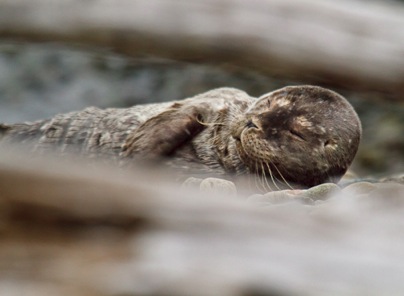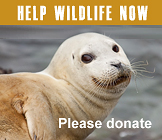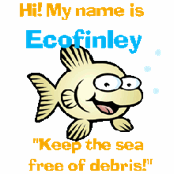Oct 2010
Weaned pups finding good food source in Elliott Bay
Oct/31/10 10:54 PM
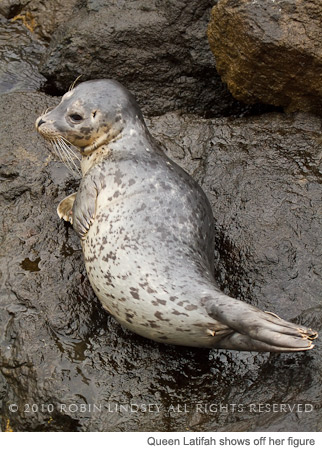
What do weaned pups eat? According to WDFW’s marine mammal research biologist, seal pups will eat just about anything they can get their little flippers on. They prefer the tiny fish like shiner perch, 3 spined sticklebacks, starry flounder, gunnel (a favorite of the cormorants as well), midshipmen (the fish, not the sailors), shrimp and squid.
Latifah is particularly successful at hunting as you can see from her curvy physique! Most weaned pups are terribly thin as they make the difficult transition to life on their own. We are thrilled that both of our City-side pups are doing so well.
Storm fattens up at PAWS
Oct/29/10 09:09 PM
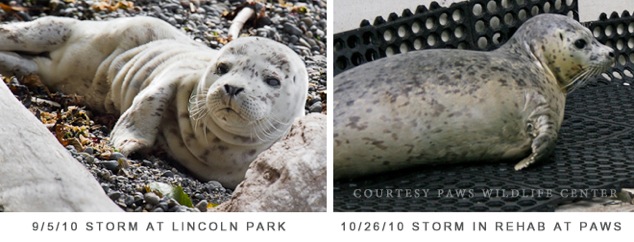 Storm is one fat and happy blubberball at PAWS. It is shocking to compare the photos of Storm on the beach at Lincoln Park to her rotund self these days. The above photo at left was taken on September 5th and Seal Sitters rescued her the next morning. For two full weeks or more at PAWS, it was uncertain if she would survive. Thanks to Kevin, PAWS’ naturalist, for sending a recent photo of her in the big pool. She is scheduled for release sometime soon and we will keep you posted with updates.
Storm is one fat and happy blubberball at PAWS. It is shocking to compare the photos of Storm on the beach at Lincoln Park to her rotund self these days. The above photo at left was taken on September 5th and Seal Sitters rescued her the next morning. For two full weeks or more at PAWS, it was uncertain if she would survive. Thanks to Kevin, PAWS’ naturalist, for sending a recent photo of her in the big pool. She is scheduled for release sometime soon and we will keep you posted with updates.Thin seal pup enjoys the morning sun on Alki
Oct/28/10 05:53 AM
Both Queen Latifah and ET hauled out on the city-side rocks again yesterday. The “queen” is on her way to breaking Pebbles’ consecutive day haul out record! Thankfully, the pups are hauling out in areas that do not require constant vigilance by our volunteers.
Seal pup ET finds new home on our shores
Oct/27/10 05:37 AM
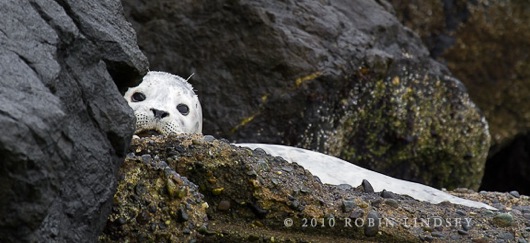
Seal tracking study in Puget Sound
Oct/26/10 04:53 AM
The Seattle Times’ environmental writer, Lynda Mapes, has a feature story about the latest tracking study being done on harbor seal pups in the San Juan Islands. Tracking devices are being secured on pups that have been rehabilitated to see how they survive once released back into the wild. The Sea Doc Society’s Harbor Seal Rehabilitation Study will compare the movements and survival rates of 10 rehabbed pups versus 10 wild-weaned pups. Read the Times article here.
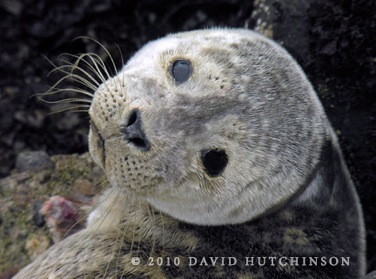 A similar study is being conducted in South Puget Sound, where 21 wild pups have been fitted with radio transmitters. Mortality rates of pups have increased somewhat in our area and biologists hope that these devices will shed light on the causes. The movements of these pups will be tracked throughout the winter. The transmitters are glued on and are shed when the pups molt their first coat. Seals molt every year post pupping season. Yesterday, we had a pup on our shore (photo at left by SS volunteer David Hutchinson) who was tagged during captures as part of long-term harbor seal research study in the region. This pup was not fitted with a transmitter because he had infected puncture wounds on his rear flippers. The biologists, however, tagged the pup with a blue id tag (indicating sex as male) and flushed and cleaned the wounds with an iodine solution. When our volunteer noticed the tag, we phoned WDFW Marine Mammal Investigations to see if the pup was one of our South Sound rookery pups. Sure enough, the pup was tagged in South Puget Sound on October 7th and the biologist was happy to hear that the pup has survived thus far. The wounds are still infected, but the pup was resting in an inaccessible area. We will keep an eye out for this beautiful pup.
A similar study is being conducted in South Puget Sound, where 21 wild pups have been fitted with radio transmitters. Mortality rates of pups have increased somewhat in our area and biologists hope that these devices will shed light on the causes. The movements of these pups will be tracked throughout the winter. The transmitters are glued on and are shed when the pups molt their first coat. Seals molt every year post pupping season. Yesterday, we had a pup on our shore (photo at left by SS volunteer David Hutchinson) who was tagged during captures as part of long-term harbor seal research study in the region. This pup was not fitted with a transmitter because he had infected puncture wounds on his rear flippers. The biologists, however, tagged the pup with a blue id tag (indicating sex as male) and flushed and cleaned the wounds with an iodine solution. When our volunteer noticed the tag, we phoned WDFW Marine Mammal Investigations to see if the pup was one of our South Sound rookery pups. Sure enough, the pup was tagged in South Puget Sound on October 7th and the biologist was happy to hear that the pup has survived thus far. The wounds are still infected, but the pup was resting in an inaccessible area. We will keep an eye out for this beautiful pup.
UPDATE: This pup has been named ET by our volunteers because of the similarity to the movie character and also because this pup, too, has travelled so far from home.

UPDATE: This pup has been named ET by our volunteers because of the similarity to the movie character and also because this pup, too, has travelled so far from home.
Seal pup takes break from storm on Alki Beach
Oct/24/10 07:44 PM
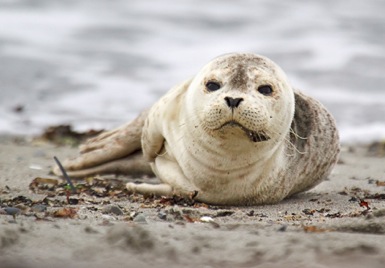
Ebb and flow determines haul out patterns of pups
Oct/24/10 05:24 AM
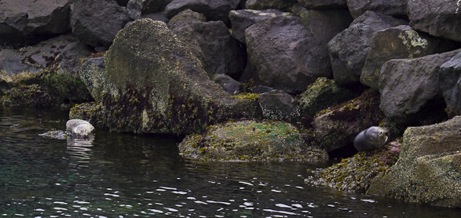
In the photo above, taken at late afternoon’s high tide, you can see Queen Latifah (on the right) who has just hauled out, along with another yet unidentified pup (on the left) who had been hauled out since the prior high tide at 7am. In the opposite photo, you can see the pup sleeping on the same rock at low tide - quite a disturbing sight to onlookers who worry that the pup is stranded.
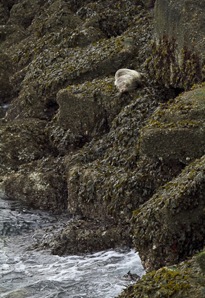
There are many factors which determine the haul out patterns of seals - and not all seals haul out at high tide. There are some haul outs that are only accessible at low tide. Other sites are accessible at all times and access is not affected by tidal influence. So, patterns appear to be site specific, but time of day, time of season, air temperature, wind and precipitation are all factors in addition to tidal heights. You can read one of many scientific papers on haul out patterns here.
UPDATE: The unidentified pup here came to be known as ET.
Pups still hanging around West Seattle
Oct/23/10 07:54 AM
Queen Latifah is very alert. In the video embedded here you can see how the pup responds to noise from rumbling garbage trucks and people walking above her on Harbor Avenue. You can also see how resilient she is in her desire to rest onshore as the water rushes over her.
Help Storm by donating to PAWS
Oct/14/10 07:41 PM
Storm is thriving in rehab at PAWS, but it is an extremely costly endeavor to rehab a seal pup - a very labor and food intensive process. We recently were able to get some video footage of Storm swimming in her big pool and being fed a tasty lunch of capelin. It is estimated that Storm’s diet runs about $350 per month. Most seal pups like herring, but Storm has an appetite for capelin, of which she consumes about 11 pounds a day! Storm will continue to grow stronger at PAWS for at least another 4-6 weeks - until she has put on a sufficient blubber store to help her survive upon release back into the wild.
Please make a donation to PAWS (designate “in honor of an animal” - West Seattle seal pup Storm) today and help pay for Storm’s gourmet meals. PAWS relies solely on donations from the public to continue their work. It is estimated that the rehab of one seal pup is approximately $10,000. If you donate, please email us and we’ll let PAWS know our readers made donations. You can also mail a check to: PAWS Wildlife Center, PO Box 1037, Lynnwood, WA 98046 (please indicate on the check that it is to go to the Wildlife Center, seal rehab).
PAWS goes the extra mile to make sure that seal pups are not given too much human exposure while in rehab so that they are not habituated to people upon release. Storm was not allowed to see us and our camera was hoisted over the top of her pool. It was very exciting to see how fat and vibrant she has become.
Pups hanging out in nooks and crannies
Oct/11/10 10:46 PM
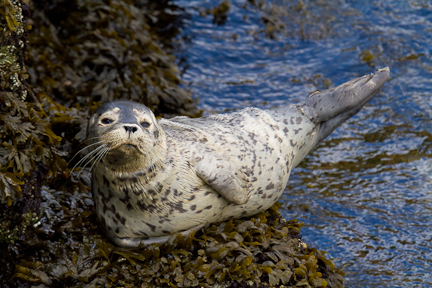
Necropsy results in for Twiggy
Oct/07/10 07:03 AM
Seal Sitters has received information regarding the necropsy results for seal pup, Twiggy, who hauled out on the south end of Alki Beach late last week. She had an abnormal liver, enlarged gall bladder and bleeding into the gastrointestinal tract. This is the third pup that SS knows of recently that has exhibited an enlarged gall bladder - the pup taken from a beach on the coast that was rehabbed successfully at PAWS, Storm who was rescued from Lincoln Park on Labor Day (and who is doing quite well at PAWS), and now this pup. Biologists do not know the root cause for this condition. Additionally, this is not the first pup that has had an abnormal liver; Twiggy’s liver was an orangish color and other dead pups have had “day-glo” orange livers according to WDFW’s marine mammal biologist. Histopaths thus far have revealed no conclusive cause for the unusual coloration.
Another pup was found dead early yesterday morning at Duwamish Head and was taken to WDFW Marine Mammal Investigations for a necropsy. This is the same pup that volunteers observed til very late the night before at the north end of Alki Beach. The pup was alert and active and there was no obvious cause for concern at that time. The pup slept comfortably among the rocks on the beach. There is a 50% mortality rate for seal pups during their first year of life. The weaning period is an extremely difficult transition for pups.
Another pup was found dead early yesterday morning at Duwamish Head and was taken to WDFW Marine Mammal Investigations for a necropsy. This is the same pup that volunteers observed til very late the night before at the north end of Alki Beach. The pup was alert and active and there was no obvious cause for concern at that time. The pup slept comfortably among the rocks on the beach. There is a 50% mortality rate for seal pups during their first year of life. The weaning period is an extremely difficult transition for pups.
Seal Sitters signage prototypes now on Alki Beach
Oct/06/10 12:35 PM
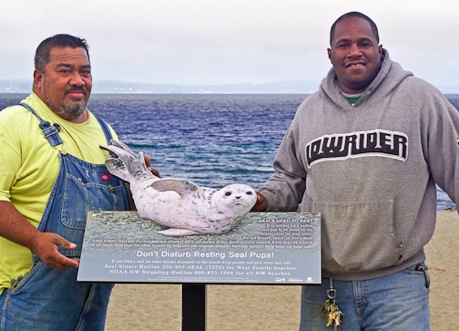
Outreach video project for Seal Sitters
Oct/06/10 06:21 AM
Life and death on Alki Beach
Oct/02/10 08:27 PM
This morning, our responder found Twiggy, still on the beach at Alki. She could see that the pup was in trouble. There was nothing to indicate last night that Twiggy had any health concerns, other than she was on the thin side. No wounds, labored breathing, or anything else to raise alarm. She simply slept peacefully on the beach access steps. However, at 5:30 this morning, her breathing was quite labored and she displayed other symptoms that she was in crisis. Twiggy was rescued from the beach - too weak to resist - and driven to PAWS. Attempts were made to stabilize her with oxygen and fluids, but the female pup died this morning. WDFW’s marine mammal biologist will perform a necropsy to determine the cause of her death. We will update you with the results when we receive them.
Another pup was found dead this morning at Constellation Park, but was not the seal pup Stella that has hauled out there the past two days. This is the time of year when pups are struggling to survive the weaning process and, sadly, we lose too many every season.
This is the most difficult facet of Seal Sitters’ work and takes a toll on everyone involved. We give heartfelt thanks to PAWS’ staff for trying to save Twiggy and thanks, as always, to Dyanna Lambourn for her sage advice very early on a Saturday morning.
Another pup was found dead this morning at Constellation Park, but was not the seal pup Stella that has hauled out there the past two days. This is the time of year when pups are struggling to survive the weaning process and, sadly, we lose too many every season.
This is the most difficult facet of Seal Sitters’ work and takes a toll on everyone involved. We give heartfelt thanks to PAWS’ staff for trying to save Twiggy and thanks, as always, to Dyanna Lambourn for her sage advice very early on a Saturday morning.
Three pups on the beach keep Seal Sitters busy
Oct/01/10 08:39 PM
A third pup hauled out late this afternoon on south Alki Beach. This long, white and somewhat thin pup has been nicknamed Twiggy and rested late into the evening tonight. Volunteers were kept very busy trying to monitor and protect Twiggy, Brownie and Stella in completely different geographic locations in West Seattle. We also received a report of a fourth pup near the lighthouse, but that pup was not located. This pup season may well surpass our bumper crop of 2007, our first year as a stranding network. Thanks to all our very tired volunteers who have donated so much of their time these past crazy weeks.
Chubby Stella lounges on Beach Drive
Oct/01/10 08:20 PM
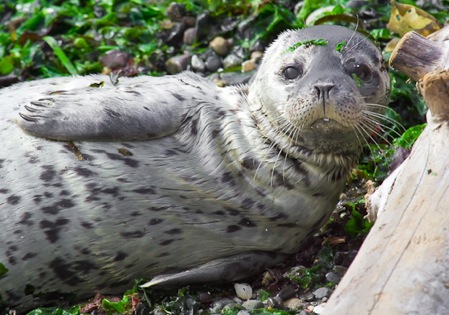
Brownie back on shore at water taxi
Oct/01/10 08:13 PM
